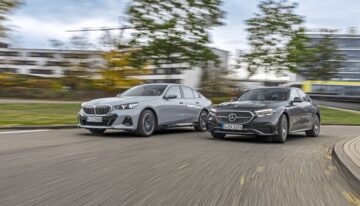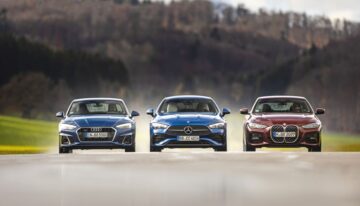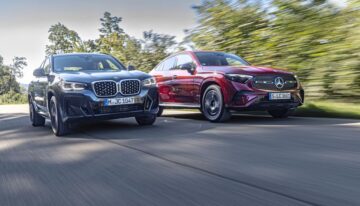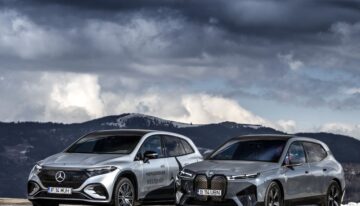The new Mercedes GLE 350 de PHEV currently offers the greatest electric range on the market. How real is it? Read in our first test.
Photo: Adrian Cobzașu
PHEV models are good for manufacturers because they reduce fleet emissions due to very low official consumption. Even the new WLTP cycle, more realistic than NEDC, failed to approach real consumption values. For customers, many PHEV models are a trick because they cost a lot more than a similar diesel or petrol model and offer low electrical range that is useless.
In this context, Mercedes launches a different PHEV model: a diesel combined with an electric motor and a very large Li-Ion battery,of 31.2 kWh, that promises an electric range between 98 and 106 km. How true are these figures? We did a road test to see what the reality is.
100 km electric range is very real
Due to the very large battery for a PHEV, the Mercedes GLE 350 de is very heavy with 2,655 kg. A kind of modern Tyranosuarus Rex. The 2-liter OM 654 diesel engine with 194 HP/400 Nm is coupled with a 100 kW/440 Nm electric motor located between the heat engine and the 9-speed automatic transmission, the assembly providing a total of 320 HP and 700 Nm.
I started the trip with the battery 100% charged on a hot day with a temperature of 36-37 degrees on a combined route city-express road-windy road and I drove at normal speed, respecting the speed limits. We managed to get a range of 100 km electrically, which is remarkable which are added to another 730 km that can be covered with the 65 liters of diesel fuel (consumption of 8.9 l/100 km after running out of battery).
Low energy consumption due to the intelligent assistance systems
But let’s get back to electric driving. It is very easy to drive electrically because in addition to the classic driving modes – Eco, Comfort, Sport, Individual and Off-road there is also the Electric mode. By switching on the Electric mode, the car travels electrically up to 140 km/h. In this case, the gearbox is in D Auto mode. What this means? If you program a navigation destination, the car will automatically brake when approaching crossroads and traffic lights. If the car in front is constantly going, Mercedes GLE 350 de will run in Coasting mode.
With these intelligent assistance systems we managed to obtain a consumption of 22.4 kWh/100 km (see the picture) in Electric mode. It is a very low energy consumption compared to the car’s weight and performance. By comparison, this consumption is obtained by compact electric SUVs like the VW ID.4.

Also, the electric range of 100 km is comparable to that obtained 8-10 years ago by the first electric models such as first generation Nissan Leaf or BMW i3. In addition to the D Auto mode, the driver has at his disposal the D, D – and D – – modes with which he can recover energy when braking. In D – – mode the car behaves almost like a car with One pedal mode, the deceleration being very brave. Also, in addition to the Electric mode, the driver also has the Battery Level mode, which allows to maintain the energy level in the battery for later use.
Charging at DC stations in only 20 minutes from 10 to 80%
There is no longer a Charge mode for charging the battery while driving, using the heat engine. Due to the very large battery, charging the battery with the help of the heat engine is no longer efficient because the fuel consumption increases a lot. Instead, Mercedes offers what no competitor offers: charging the battery at high-power DC stations. Thus, the 31.2 kWh battery is charged from 10 to 80% at DC stations in only 20 minutes, which makes it possible to charge the battery not only at home or at work but also in parking lots at malls.
Mercedes only communicates the gross battery capacity of 31.2 kWh. We charged from 0 to 100% 26 kWh. In the electric mode we consumed 22.4 kWh in the 100 km, which means that there is always a reserve in the battery when the electric range reaches zero. Thus, it is explained that in the case of accelerations, the thermal engine is always supplied by the electric motor and you feel always the high torque of 700 Nm, but it also explains the acceleration from 0 to 100 km / h which is achieved in only 6.8 seconds.

It is clear that the 2-liter turbodiesel engine with 194 HP could not push the 2655 kg car with such determination without the contribution of the electric engine.
What happens when the battery power runs out? Then Mercedes runs like a full hybrid model and the consumption oscillates between 7 l/100 km in Eco mode and 8.9 l/100 km for a more alert driving.
The noise level is very low and only at strong accelerations you can hear the hum of the 4-cylinder diesel engine.
The optional Airmatic suspension offers a better compromise
The optional air suspension (2142 euros) is worth ordering because the drive train is more balanced. In Comfort mode, the suspension is very soft and the body roll is quite large. When driving on windy roads, Sport mode is more suitable because it reduces body roll and offers a more precise driving.
In fast corners, however, the back feels heavy and there is a certain inertia. The 4-cylinder engine is mounted almost entirely behind the front axle and thus the understeer reaction is reduced. In fast corners you can feel the big weight and the higher center of gravity, but on the other hand the Mercedes GLE 350 is an excellent cruiser.
How much does it cost? The price is even lower than the GLE 400 d diesel. With a price of 80,719.95 euros (without subsidies offered in various countries), the Mercedes GLE 350 d 4Matic is 1000 euros cheaper than the Mercedes GLE 400d 4Matic (81,717.30 euros) . So, it is very well postioned in therms of price. And with subsidies which goes to 5,625 euro in Germany for PHEV cars with a netto price between the 40,000 and 65,000 euro, the final price is around 75,000 euro.
Verdict
The new Mercedes GLE 350 de 4Matic is a 2 in 1 car with 100 km real electric range plus another 730 km with diesel fuel. A great car for long journeys which can be driven for 100 km with zero emissions. The battery can be charged at DC stations – a unique feature for a PHEV model. The price of around 80,000 euros is lower than that of GLE 400 d 4matic and you can get subsidies of up of 5,600 euros depending of the country.
| Model | GLE 350 de 4Matic |
|---|---|
| Engine type | L4, turbodiesel |
| Displacement (cc) | 1950 |
| Max.power/revs (HP/rpm) | 194/3800 |
| Max. torque/revs (Nm/rpm) | 400/1600 |
| Electric engine | |
| Max. power (HP) | 136 |
| Max. torque (Nm) | 440 |
| Total power (HP) | 320 |
| Total torque (Nm) | 700 |
| Traction | 4wd |
| Transmission | 9G-Tronic |
| L/w/h (mm) | 4924/1947/1795 |
| Wheelbase (mm) | 2995 |
| Boot capacity(l) | 490-1915 |
| Kerb weight(kg) | 2655 |
| Maximum speed (km/h) | 210 |
| Acceleration 0-100 km/h (s) | 6,8 |
| Combined fuel consumption (l/100 km) | 0,5 l/100 km |
| Emission CO2 (g/km) | 18 |
| MEASUREMENTS | |
| Accelerations (s) | |
| 0-80 km/h (s) | 4,7 |
| 0-100 km/h (s) | 6,9 |
| 0-130 km/h (s) | 11,2 |
| 0-160 km/h (s) | 17,4 |
| 0-200 km/h (s) | 32,8 |
| Braking (m) | |
| from 100 km/h, cold (m) | 34,3 |
| from 130 km/h, cold (s) | 56,3 |
| Fuel consumption (l/100km-kWh/100 km) | |
| Fuel consumption Eco (l/100 km) | 7,0 |
| Fuel consumption Normal (l/100 km) | 8,9 |
| Energy consumption in electric mode (kWh/100 km) | 22,4 |
| Electric range | 100 |
| PRICE | |
| Mercedes GLE 350 de 4Matic (euro, with VAT) | 80.719,55 |




















